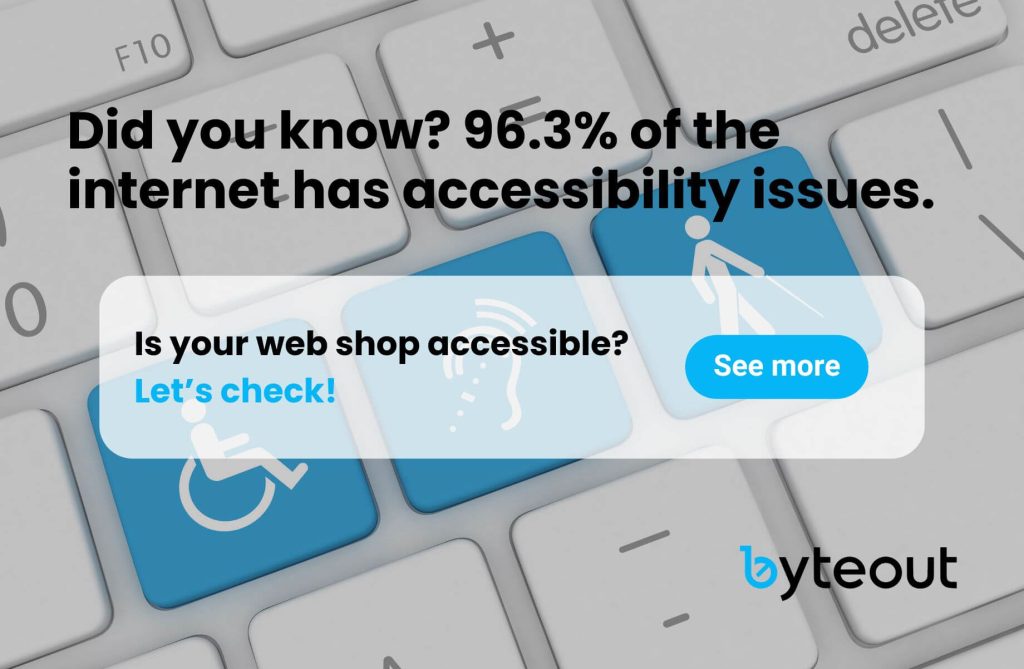
The importance of website accessibility: Enhancing user experience
In today’s digital age, websites serve as gateways to information, products, and services. But it’s important to recognize that not all users have the same abilities or disabilities. Website accessibility ensures that everyone, regardless of their disabilities or limitations, can navigate and engage with online content effectively.
Let’s explore the significance of website accessibility, its benefits, essential considerations for designing an inclusive digital experience, additional strategies and best practices to promote accessibility, and what the future of website accessibility looks like.
Table of contents
What is website accessibility?
Website accessibility refers to the inclusive design and development practices that enable individuals with disabilities or impairments to perceive, understand, navigate, and interact with websites effectively. Disabilities may include visual, auditory, motor, cognitive, or neurological impairments. The goal of website accessibility is to remove barriers and provide equal access to information and services for all users.
Why is website accessibility important?
Website accessibility is important because it gives equal access and inclusion for all users, regardless of their abilities or disabilities. According to the World Health Organization, nearly 16% of people on our planet suffer from some form of disability. Taking care of their needs is our ethical responsibility and a legal requirement in many developed countries.
The US alone had more than 3200 lawsuits in 2022 based on website accessibility claims (with many more settled out of court), and it is expected that the number of these lawsuits in 2023 will pass 3500, and we can only see this number increasing. Given all of the above, the importance of having an accessible website is more than evident.

Equality and inclusivity
Accessible websites promote equality and inclusivity by ensuring that individuals with disabilities have equal opportunities to access information and services and participate in online activities.
Legal compliance
Legal compliance in website accessibility is of utmost importance as it ensures that individuals with disabilities are protected by law and have equal access to digital content and services. Numerous countries and regions have implemented laws, regulations, and guidelines to promote accessibility and hold organizations accountable for providing inclusive online experiences. Here are some key aspects of legal compliance in website accessibility:
Americans with Disabilities Act (ADA) (United States): The ADA prohibits discrimination against individuals with disabilities and requires equal access to public accommodations, including websites. The ADA has been interpreted to include websites as places of public accommodation, making it essential for organizations to ensure their websites are accessible to individuals with disabilities. Non-compliance with ADA accessibility requirements can result in legal actions and substantial financial consequences.
Web Content Accessibility Guidelines (WCAG): The WCAG, developed by the World Wide Web Consortium (W3C), provides internationally recognized standards for web accessibility. It offers a set of guidelines and success criteria that organizations can follow to make their websites more accessible. Many countries widely adopt the WCAG and serves as a valuable resource for legal compliance and accessibility best practices.
Section 508 (United States): Section 508 of the Rehabilitation Act requires federal agencies to make their electronic and information technology accessible to individuals with disabilities. It sets specific accessibility standards that federal websites and digital content must meet. Private organizations that receive federal funding or contracts are also required to comply with Section 508 standards.
European Accessibility Act (EAA) (European Union): The EAA aims to harmonize accessibility requirements across the European Union (EU) member states for a wide range of products and services, including websites. It sets out accessibility obligations for public-sector websites and encourages private-sector organizations to ensure their digital services are accessible. The EAA promotes the use of the WCAG as a recognized standard for web accessibility.
National and Regional Accessibility Laws: Many countries have their own accessibility laws and regulations that complement or expand upon international guidelines. For example, the Canadian Accessibility for Ontarians with Disabilities Act (AODA) and the United Kingdom Equality Act 2010 outline specific requirements for accessibility in websites and digital services within their jurisdictions.
Non-compliance with website accessibility laws and regulations can have significant consequences, including:
Legal action: Individuals or advocacy groups may file lawsuits against organizations that fail to provide accessible websites, alleging discrimination and violation of accessibility laws. Legal actions can result in financial penalties, settlements, and reputational damage.
Loss of business opportunities: Inaccessibility can lead to lost business opportunities, as potential customers with disabilities may be unable to access or engage with products and services. Inaccessible websites can also deter individuals from making purchases or engaging with organizations.
Damage to reputation: Failure to prioritize accessibility can result in negative publicity and damage to an organization’s reputation. In today’s interconnected world, news of accessibility issues can spread quickly, leading to public scrutiny and a loss of trust among consumers.
To ensure legal compliance in website accessibility, organizations should consider the following steps:
- Familiarize yourself with applicable laws. Stay updated with accessibility laws and regulations specific to your jurisdiction and industry. Understand the requirements and obligations they impose on your organization.
- Adopt accessibility standards. Follow recognized accessibility standards, such as the WCAG, as a baseline for your website’s accessibility. Strive to meet or exceed the recommended guidelines.
- Conduct accessibility audits. Regularly assess your website’s accessibility through comprehensive audits performed by knowledgeable accessibility experts. Identify areas of non-compliance and take steps to address them.
- Implement accessibility policies and procedures. Develop and implement internal policies and procedures that prioritize accessibility throughout the organization. Train employees on accessibility best practices and provide resources to
Business advantages
In addition to the ethical and legal considerations, accessible websites also provide significant business advantages. By accommodating users’ diverse needs, organizations can tap into new markets and reach a larger audience. Accessible websites improve brand reputation, customer loyalty, and customer satisfaction. Moreover, accessible websites often have better search engine optimization (SEO), resulting in improved visibility and increased traffic. We’re passionate about website accessibility and offer services that help brands become accessible.
Key considerations for website accessibility
When designing for website accessibility, key considerations need to be taken into account to ensure that all users can perceive, navigate, and understand the content effectively.
Create accessible web content by following the POUR principles, which stand for making the content perceivable, operable, understandable, and robust to ensure inclusivity for all users.
Perceivable content
One of the key aspects of website accessibility is making content perceivable to all users. Consider some of the following best practices:
Use alternative text (alt text) for images: Alt text should be descriptive and convey the purpose of the image. This enables individuals with visual impairments to understand the content.
Provide captions and transcripts for multimedia content: Captions and transcripts allow individuals with hearing impairments to access the information presented in videos and audio.
Ensure color contrast: High contrast between text and background elements makes content easier to read for users with visual impairments. Use tools and guidelines to check and improve color contrast ratios.
This list is not exhaustive, and there are more ways to make your content perceivable to users, but for the beginning, you can start with these three suggestions.
Operable features
Operability refers to the ease of use and interaction with website features. To ensure operability for all users, consider the following:
Implement keyboard navigation: Some users cannot use a mouse due to motor disabilities. Providing keyboard navigation allows them to navigate the website effectively.
Avoid reliance on hover or mouse gestures: Some users may have difficulty using a mouse, so it’s important to provide alternative methods of interaction, such as clickable buttons or menus.
Provide clear and consistent navigation: A well-structured and consistent navigation system enables users to move seamlessly between pages and sections. Clear labels and intuitive navigation menus are essential for ease of use.
Understandable information
To enhance the understandability of website content, consider the following:
Use clear and concise language: Avoid jargon or complex terminology that may be difficult for some users to understand. Use plain language that is easily comprehensible to a wide range of users.
Organize content with headings, subheadings, and bullet points: Clear headings and logical structure help users with cognitive disabilities or those who skim content to find relevant information quickly.
Offer helpful error messages and instructions: When users encounter errors or require instructions, provide clear and concise messages that guide them in resolving issues without frustration.
Robust functionality
Ensuring that the website functions robustly across different devices and assistive technologies is crucial for accessibility. Consider the following:
Compatibility with assistive technologies: Ensure that the website is compatible with screen readers, voice recognition software, and other assistive technologies. Properly implementing ARIA (Accessible Rich Internet Applications) attributes and using semantic HTML help improve compatibility.
Use standard HTML and coding practices: Following web standards and best practices ensures that websites can be accessed by a wide range of devices and assistive technologies. This includes proper use of headings, semantic tags, and descriptive links.
Regularly test the website for accessibility: Conduct regular accessibility audits and testing to identify and address any accessibility issues. Testing can include using screen readers, keyboard navigation, and other assistive technologies to simulate the experience of users with disabilities.
Additional strategies for website accessibility
In addition to essential considerations, implementing additional strategies further enhances website accessibility, catering to users’ diverse needs and fostering a more inclusive digital experience.
Text-to-speech and speech recognition
Providing text-to-speech functionality allows users with visual impairments to have the content read aloud, while speech recognition enables users to interact with the website using voice commands. These features enhance accessibility for individuals who may have difficulty reading or using traditional input methods.
Accessibility training and audits
Organizations should invest in accessibility training for their web designers, developers, and content creators. Training helps raise awareness of accessibility issues and equips professionals with the knowledge and skills to implement accessible design practices. Conducting regular accessibility audits can help identify and rectify any accessibility gaps. We do website accessibility checkups with manual blind user testing.
User testing and feedback
Engaging users with disabilities in user testing and obtaining feedback is essential for understanding their needs and identifying areas for improvement. This iterative process ensures continuous enhancements to website accessibility. Feedback from users with disabilities provides invaluable insights and helps create a user-centered design approach.
Responsive design
Implementing responsive design ensures that websites adapt to different screen sizes and devices, improving accessibility for users who rely on mobile devices or have limited screen real estate. Responsive design enables the content to be presented in a user-friendly manner across various devices.
Key considerations in responsive design for accessibility
Flexible layouts: Responsive design involves using fluid grids and flexible layout structures that automatically adjust and reflow content based on screen size. This allows users with visual impairments or those using magnification tools to view and navigate content without horizontal scrolling or loss of information.
Scalable typography: Implementing responsive typography involves using relative font sizes and scalable typography that adapts to different screen sizes. This ensures that users can adjust the font size according to their needs and preferences, benefiting individuals with visual impairments or reading difficulties.
Media queries: Media queries are CSS rules that apply specific styles based on the characteristics of the user’s device, such as screen width, height, and resolution. By using media queries, designers can optimize the presentation of content and user interface elements for different devices, ensuring a consistent and user-friendly experience.
Mobile-first approach: Adopting a mobile-first approach in responsive design involves prioritizing the design and development of websites for mobile devices first and then progressively enhancing the experience for larger screens. This approach helps ensure that essential content and functionality are accessible to users on smaller screens and slower connections.
Touch-friendly interactions: With the prevalence of touchscreens, responsive design should prioritize touch-friendly interactions. This includes designing buttons, links, and interactive elements with sufficient size and spacing to accommodate users with motor impairments or those using touch-assistive technologies.
Image optimization: Responsive design also involves optimizing images to ensure fast loading times and optimal display on different devices. By using responsive image techniques, such as lazy loading or using multiple image versions, designers can minimize bandwidth usage and provide an efficient browsing experience.
Benefits of responsive design for accessibility
Enhanced user experience: Responsive design creates a consistent and seamless user experience across various devices, enabling individuals with disabilities to access content without barriers or limitations. Users can navigate, interact with, and consume information without encountering usability issues caused by unoptimized layouts.
Improved search engine visibility: Responsive design positively impacts search engine optimization (SEO) by providing a single URL and consolidated content, resulting in improved visibility in search engine rankings. This benefit applies to both desktop and mobile searches, enhancing discoverability and accessibility for users seeking relevant content.
Cost and maintenance efficiency: With responsive design, organizations can maintain a single website that automatically adapts to different devices, reducing the need for separate mobile websites or dedicated apps. This consolidation simplifies maintenance, updates, and content management, ensuring that accessibility features and improvements are consistently applied throughout the website.
Innovations in website accessibility
The future of website accessibility is being shaped by technologies like Artificial Intelligence (AI), Machine Learning (ML), Virtual Reality (VR), Augmented Reality (AR), and the Internet of Things (IoT). These technologies have the potential to make digital content more inclusive and accessible to individuals with disabilities. By leveraging these technologies, website accessibility can be significantly improved, creating a more inclusive digital world. However, addressing ethical considerations is crucial, ensuring robust data privacy, and adopting a human-centered approach.
If you want to learn more about the future of web accessibility, read this article.
Conclusion
Website accessibility is a legal and ethical responsibility and a pathway to a more inclusive digital society. By embracing and implementing accessible design principles, businesses and organizations can provide equal access to their digital content and enhance the user experience for all individuals, regardless of their abilities or disabilities. Investing in website accessibility is an investment in inclusivity, diversity, and a more equitable online environment. Let us strive for a future where all users can navigate the web with ease, regardless of their individual abilities. We can help to make your brand fully accessible!

